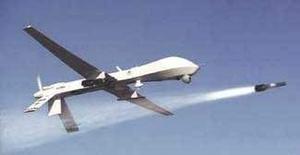AfricaU.S. to build drone base in Niger
With the war in Mali raging, the U.S. Africa Command is now establishing a drone base in northwest Africa in order to bolster U.S. surveillance – and operational — capabilities against Islamist groups in the region. Initially, the drones flying from the base will conduct unarmed surveillance missions, but there is little doubt that if targets present themselves, these drones will be equipped with missiles and go on hunting-killing missions.

Predator drone firing a Hellfire missile // Source: commons.wikimedia.com
On 1 October 2008, after nearly two years of planning, the U.S. Africa Command was established, signaling the growing importance of Africa to U.S. national security. The command is responsible for U.S. military operations and military relations with fifty-three of the African continent’s fifty-four independent countries (one African country, Egypt, is part of the area of responsibility of the U.S. Central Command).
Two developments have exacerbated the security situation in Africa.
The first is the success of the Obama administration’s campaign against terrorist havens in northwest Pakistan. The cumulative effect of the relentless drone campaign the United States has been conducting since early 2009 has forced al Qaeda and a Qaeda-affiliated organizations to look for other places to serve as bases of operations. Yemen and Somalia were initially viewed as good locations, but U.S. drones reached the terrorist hideouts there, and in the case of Somalia, neighboring countries such as Ethiopia and Kenya kept sending their own militaries in to fight the Islamists.
These Islamists soon came to regard the western part of the Sahel — a vast stretch of largely empty territory, consisting of desert, semi-arid grasslands, savannas, and steppes, covering parts of Niger, Mali, Burkina Faso, and Mauritania — as the ideal area from which to begin and launch their operations.
The second development has been the Arab Spring, which saw authoritarian regimes often replaced by weak and fractured governments, the mushrooming of ethnic- and religion-based militias, and the loss of central control over large arsenals of sophisticated arms of all types.
The takeover in April 2012 of north Mali by the Islamist Ansar Dine movement, and the battle now waged by France to evict the Islamists and allow for the reunification of Mali, are but one example of how the Islamists’ growing influence in the western Sahel combines with the chaos created by the Arab Spring to create a new reality. Ansar Dine was able to take over north Mali after it had joined with Malian Tuareg soldiers who had served in Col. Qaddafi’s army – and who, in November 2011, escaped Libya with their weapons when Qaddafi was toppled. The Tuareg and the Islamists collaborated to defeat the Malian army and declare the independence of north Mali, which they named Azawad.
With the war in Mali raging, the U.S. Africa Command is now establishing a drone base in northwest Africa in order to bolster U.S. surveillance – and operational — capabilities against Islamist
